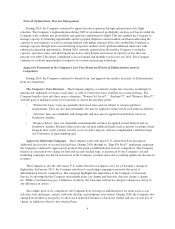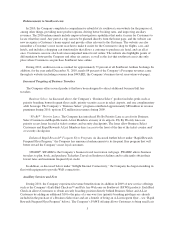Southwest Airlines 2010 Annual Report Download - page 20
Download and view the complete annual report
Please find page 20 of the 2010 Southwest Airlines annual report below. You can navigate through the pages in the report by either clicking on the pages listed below, or by using the keyword search tool below to find specific information within the annual report.enables the Company to continue to profitably charge competitive fares. In addition, the Company does not tack
on additional fees for items such as first and second checked bags, flight changes, seat selection, fuel surcharges,
snacks, curb-side checkin, and telephone reservations.
The Company also competes based on markets served, flight schedules, and frequent flyer opportunities.
Some major U.S. airlines have more extensive route structures than does the Company, including international
routes. In addition, many have entered into significant commercial relationships with other airlines, such as
codesharing and capacity purchase agreements, which increase the airlines’ opportunities to expand the routes
they can offer. For example, a codesharing agreement enables an airline to offer flights that are operated by
another airline and also allows the airline’s customers to book travel that includes segments on different airlines
through just one airline. As a result, depending on the nature of the specific codesharing arrangement, a
participating airline may be able to (i) offer its customers access to more destinations than it would be able to
serve on its own, (ii) gain exposure in markets it does not otherwise serve, or (iii) increase the perceived
frequency of its flights on certain routes. Codesharing arrangements not only provide additional route flexibility
for participating airlines, they can also allow these airlines to offer their customers more opportunities to earn
frequent flyer miles. A capacity purchase agreement enables an airline to expand its route structure by paying
another airline (e.g., a regional airline with smaller aircraft) to operate flights on its behalf in markets that it does
not, or cannot, serve itself. As discussed above under “Operating Strategies and Initiatives,” the Company
continues to evaluate and implement projects to better enable it to enter into codesharing relationships and offer
international itineraries. In November 2010, the Company launched a new service that allows its Customers to
book international flights by connecting with Volaris, Mexico’s second largest airline. In addition, the
Company’s anticipated acquisition of AirTran would enable the Company to expand its presence in key markets
it already serves, extend its service to many smaller domestic cities that it does not yet serve, and provide access
to key near-international markets in the Caribbean and Mexico.
The Company also competes with other airlines in areas of Customer Service such as ontime performance,
passenger amenities, equipment type, and comfort. According to statistics published by the DOT, the Company
consistently ranks at or near the top for Customer Satisfaction for having the lowest Customer complaint ratio.
The airline industry is subject to varying degrees of competition from surface transportation by automobiles,
buses, and trains. Inconveniences and delays associated with air travel security measures can increase such
surface competition. In addition, surface competition can be significant during economic downturns when
consumers cut back on discretionary spending. Because of the relatively high percentage of shorthaul travel
provided by the Company, it is particularly exposed to competition from such surface transportation in these
instances. The airline industry is also subject to competition from alternatives to travel such as videoconferencing
and the Internet, which can also increase in the event of travel inconveniences and economic downturns. The
Company is subject to the risk that air travel inconveniences and economic downturns may, in some cases, result
in permanent changes to consumer behavior in favor of surface transportation and electronic communications.
Seasonality
The Company’s business is somewhat seasonal. Generally, in most markets the Company serves, demand
for air travel is greater during the summer months, and therefore, revenues in the airline industry tend to be
stronger in the second (April 1 – June 30) and third (July 1 – September 30) quarters of the year than in the first
(January 1 – March 31) and fourth (October 1 – December 31) quarters of the year. As a result, in many cases,
the Company’s results of operations reflect this seasonality. Factors that could alter this seasonality include,
among others, the price of fuel, general economic conditions, extreme or severe weather, fears of terrorism or
war, or changes in the competitive environment. Therefore, the Company’s quarterly operating results are not
necessarily indicative of operating results for the entire year and historical operating results in a quarterly or
annual period are not necessarily indicative of future operating results.
14
























